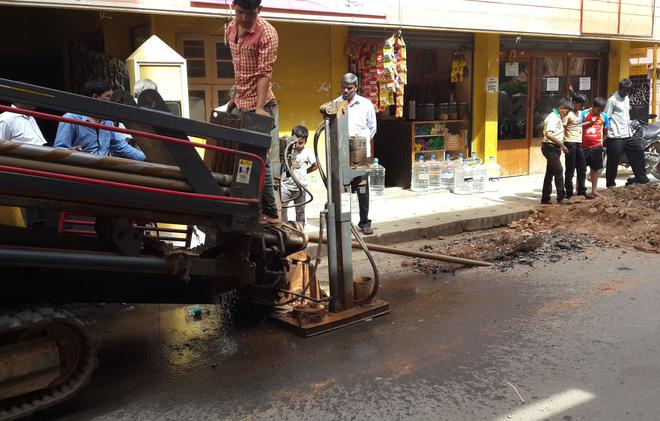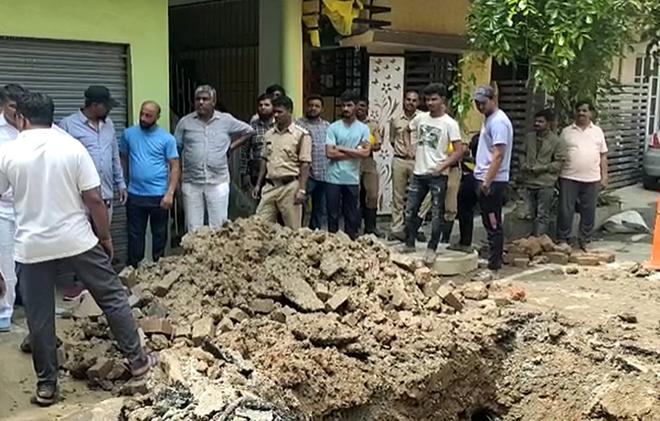Safer, cheaper, and far easier to use than LPG cylinders, piped natural gas (PNG) should have spread its network far and wide across Bengaluru by now. But poor multi-agency coordination triggering dangerous leaks, glaring awareness gaps, and lack of an official push have all slowed down the expansion of the network.
The city’s underground is a chaotic maze of sewage and water lines, electric and OFC cables. To make any sense of the crisscrossing lines, active coordination between multiple utility agencies is critical. The entry of GAIL Gas, with its network of high and low-pressure pipelines, meant that any digging by any agency had to follow a well-crafted standard operating procedure (SOP).
GAIL India insists that its sound and tested SOP has been shared with all the utility agencies. The SOP mandates that the agencies take permission from the gas utility before undertaking repair/maintenance work and immediately alert it in case of a leak. The agencies include the Bangalore Water Supply and Sewerage Board (BWSSB), the Bruhat Bengaluru Mahanagara Palike (BBMP), the Bangalore Electricity Company Limited (Bescom) and the multiple OFC cable companies.

Poor multi-agency coordination
Poor coordination issues had come to the fore yet again in March 2023 when a leaking gas pipeline triggered blasts in three houses in the city’s HSR Layout. It turned out that the utility agencies had neither obtained the mandated permission from GAIL nor reported the damage in time. If alerted, the gas firm could plug the leak quickly. But when the frequency of such leaks are at least twice a week as reported, the danger could amplify.
This implies that no lessons were learnt from the Whitefield leakage in October 2018. The incident on ITPL Main Road led to widespread panic amongst locals and commuters. Investigations confirmed that the Metro contractor tasked with the drilling work had failed to take the necessary permission from GAIL and fled the scene when things went out of control. Traffic on the entire stretch was blocked for hours.
A GAIL Gas India spokesperson recalls that the contractor had failed to intimate it well in advance. “Besides, the contractor had been blacklisted before. He had done it in a number of instances in the past. He was given a written warning too, and when the leakage happened, he just ran away from the spot. This is just not acceptable,” the spokesperson notes.
Awareness campaign
To avoid a repeat of such major leakages, GAIL has intensified its awareness campaigns. “Now we are going to all the utility agencies and insisting that the SOP be followed strictly. There is an ongoing awareness and sensitization programme. We are educating them on what to do before taking up digging; how to inform us.”
The campaign also engages with the public. “There are markers placed with maps along the pipeline routes, and there are numbers. We ask people to alert us by calling those toll-free numbers when they spot any digging or start any digging. The alert should go to the common people too,” the spokesperson informs.
Tackling gas pipeline leaks can get tricky without expertise. Recalls Partha Jana, a retired official of the gas firm, “I remember that an OFC company had dug up the road and punctured the line. But when they spotted the gas leak, they just taped it and left. You cannot hold back the gas with such material, and the leak continued and caused a fire. These companies and agencies should be aware that they are also part of the system. They have to be safety-oriented.”

Horizontal Directional Digging
GAIL and many OFC companies prefer the Horizontal Directional Digging (HDD) method to digging trenches. But this can be undertaken only after extreme planning and studying what lies underneath. As Partha points out, “The OFC contractors take up the HDD work in the night and vanish by the morning. They don’t inform GAIL Gas. Gas lines are punctured, and the gas firm is not even informed. When we do the HDD work, we study the area thoroughly before fixing the pipe alignment.”
Since Bengaluru’s chaotic network of underground pipes and cables are not mapped or part of any road history project, the GAIL gas lines are laid 1.2 metres beneath the ground. This is adopted in all the 16 geographical areas where the network expansion is currently on.
Safer than LPG cylinders
Despite the leakages reported mostly on main roads, the use of domestic piped natural Gas (DPNG) is generally considered much safer than LPG (liquified petroleum gas) cylinders. The GAIL spokesperson explains, “Pressure at the household level is low since that is adequate for cooking. If someone has left the knob on, and there is a leakage, the gas disperses because it is lighter than air. Unlike LPG, the gas does not settle down at the ground level.”
Besides, the leaked gas does not attain ignition temperature. “So, it does not catch fire even when you light a candle or match. In case of a leak, open the windows, and it will disperse.” However, the gas is supplied at a much higher pressure to commercial and industrial units.
2.47 lakh connections
Currently, GAIL has 2.47 lakh households connected with DPNG in the Bengaluru zone. “Work started in February 2015 to eventually spread the gas pipeline network over an area of 4,395 sq.km. extending to the entire Bengaluru rural and urban districts. Till May 2023, approximately 1,900 km of steel and Medium Density Polyethylene Pipe (MDPE) pipelines have been laid,” informs an official.
The COVID lockdown did affect the network expansion. “There have been a lot of ups and downs during that period. But Bengalureans are very educated and know the advantages of PNG. Once the network is fully ready, the adoption will improve. We are already at a stage – after a long gestation period of laying the pipelines – where the pace is picking up.”
Compared to residential areas, the network’s expansion in industrial localities has been faster. Over 180 industries are now linked to the gas pipeline network. Bommasandra, Jigani, Hosakote, Yelahanka, Whitefield, Old Madras Road, Electronic City, Singasandra, Veerasandra, Peenya, Dabaspet and Attibele are among the key industrial areas served.







